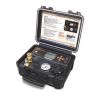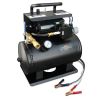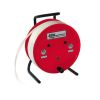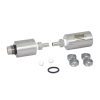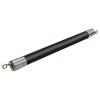Solinst Model 408 Stainless Steel Double Valve Pump
Features
- Positive displacement, gas drive pump provides consistent samples with excellent VOC results
- Pneumatic drive pumps are well suited for pumping contaminant liquids
- No bladder replacement is required, and provides higher pumping rates than bladder pumps
- Expedited repair and warranty service
- Lifetime technical support
- More
The DVP is suitable for low flow or regular flow sampling. The stainless steel pumps can operate to depths of 500 ft (150 m) and the PVC Double Valve Pump can operate to depths of 100 ft (30 m). Everything is easily accessible; replaceable and with interchangeable parts. All components can be cleaned with mild detergent or non-phosphate soap. Pumps are not damaged by operation in sediment laden water, or in dry pumping conditions.
When the pump is placed in a well or borehole, water rises inside the pump and the tubing to static level. Gas supplied from the Controller pushes down on the water column contained in the drive line tubing, closing the check valve at the base of the pump. This forces water up the sample line tubing.
A vent period, during which the gas is released, allows hydrostatic pressure to refill the pump and drive line with sample water. The top check valve prevents water in the sample line from falling back into the pump body. This pressurization and vent cycle is repeated to bring water to the surface.
For proper collection of volatiles, the pressure applied must never be high enough, nor the drive period long enough, to enable gas to enter the body of the pump and aerate the sample. If operated properly, air will never come in contact with the sample water, which produces high quality VOC samples comparable to those of a bladder pump.
Flow rates vary with depth of pump below surface, depth below water level, size of drive and sample tubing, drive and vent cycle times, gas pressure applied, aquifer recharge, and size of pump body.
- Solinst Model 408 Stainless Steel Double Valve Pump Specifications
- Solinst Model 408 Stainless Steel Double Valve Pump Operating Principles
- Solinst Model 408 5/8" Stainless Steel Double Valve Pump Operating Instructions
- Solinst Model 408 1.66" Stainless Steel Double Valve Pump Operating Instructions
In The News
Solinst groundwater samplers: Versatile options for a variety of applications
Groundwater sampling can be a challenging task that requires different tools for different applications. Solinst groundwater samplers offer the capability to obtain commonly needed representative samples of groundwater using different approaches of water withdrawal. Solinst’s 425 Discrete Interval Sampler uses passive sampling to grab water from a specific depth. The 407 Bladder Pump enables continuous airtight low flow sampling. The 408 Double Valve Pump can continuously sample at variable rates. “One sampler isn’t necessarily going to be for every site,” said Randy Blackburn, Solinst product manager. Each has different means of fluid sampling. The 425 sampler relies on a manual air pump that pressurizes the sampler based on the water depth.
Read MoreCombating Water Insecurity in Saskatchewan with Real-Time Data
The prairies of Saskatchewan can be described as one of the least water-secure parts of Canada, making water quality monitoring essential for informed resource management in a region already facing water insecurity. While natural physical properties worsen some of the poor water quality conditions in the region, others are connected to land use. Having grown up spending summers on the shores of Lake Huron, Helen Baulch, an associate professor at the School of Environment and Sustainability at the University of Saskatchewan , has always been dedicated to the protection of water resources. Looking back fondly at her childhood playing along the shore, Baulch also recalls the invasion of quagga mussels during her teenage years and watching the lake change as a result.
Read MoreSeametrics Turbo Turbidity Logger: Boost your Turbidity Monitoring
The Seametrics Turbo Turbidity Logger is a self-cleaning turbidity sensor capable of internally logging over 260,000 data records. The sensor enables researchers, compliance officers, and contractors to monitor turbidity in various applications, from construction and dredging sites to wastewater effluent. Due to its narrow width, this device can be deployed in a range of areas, from small well spaces to rivers and streams. The stainless steel housing and built-in wiper allow the sensor to withstand long-term deployments and reduce the need for maintenance trips. The logger accurately records temperature and turbidity up to a depth of 50 meters.
Read More















